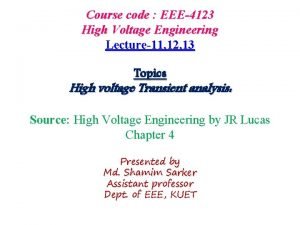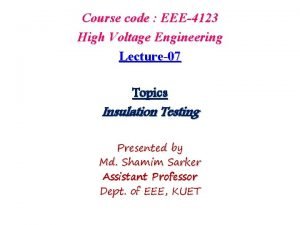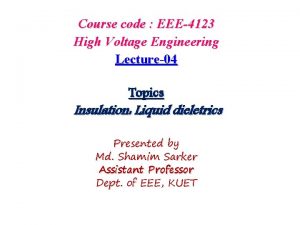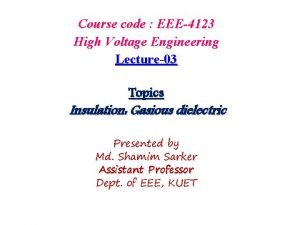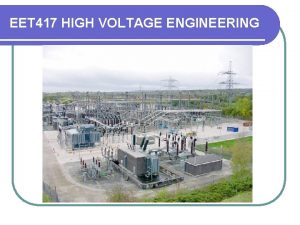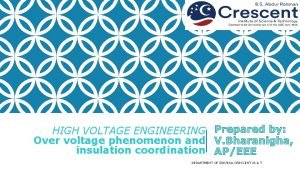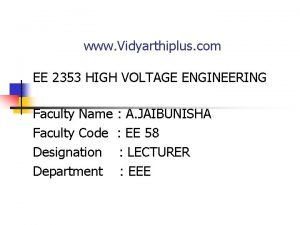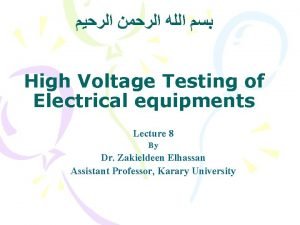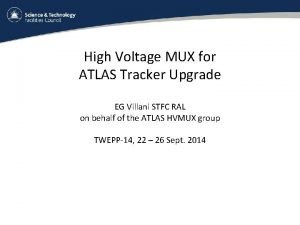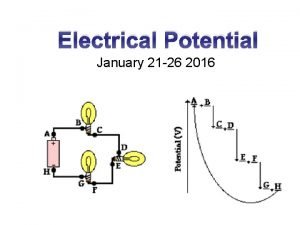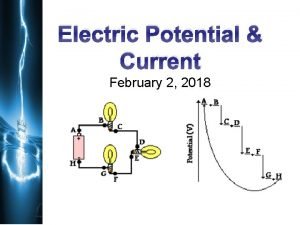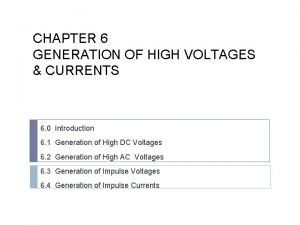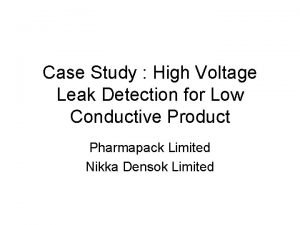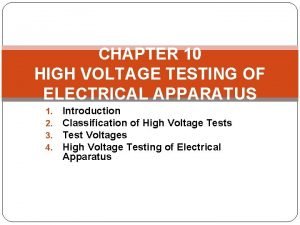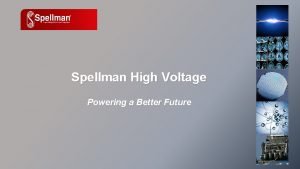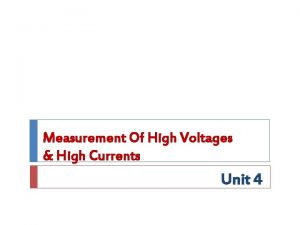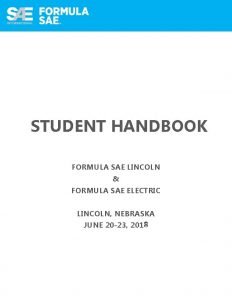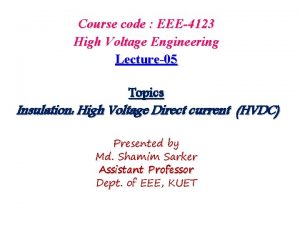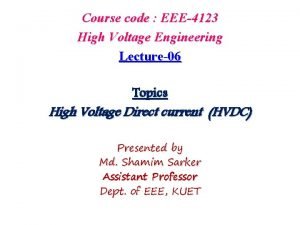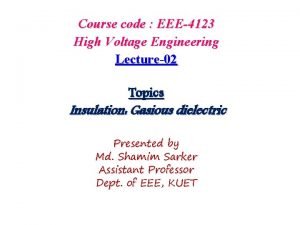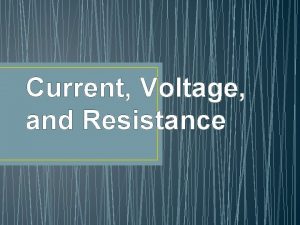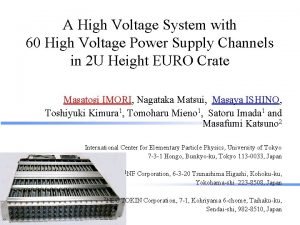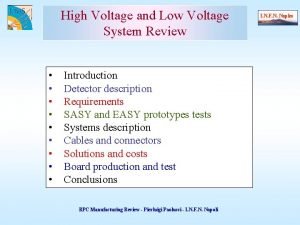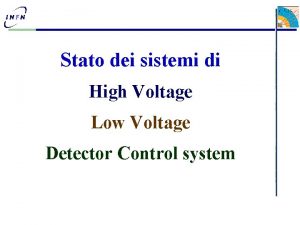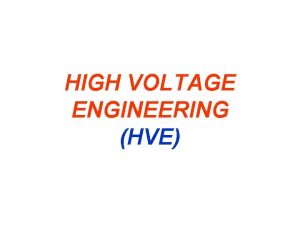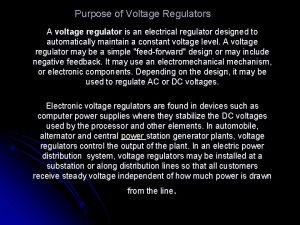Course code EEE4123 High Voltage Engineering Lecture09 10


























- Slides: 26

Course code : EEE-4123 High Voltage Engineering Lecture-09, 10 Topics Lightening phenomena Presented by Md. Shamim Sarker Assistant Professor Dept. of EEE, KUET

Lightning An electric discharge between cloud and earth, between clouds or between the charge centres of the same cloud is known as lightning. How cloud acquire charge? (i) During the uprush of warm moist air from earth, the friction between the air and the tiny particles of water causes the building up of charges. (ii) When drops of water are formed, the larger drops become positively charged and the smaller drops become negatively charged. (iii)When the drops of water accumulate, they form clouds, and hence cloud may possess either a positive or a negative charge, depending upon the charge of drops of water they contain. (iv)The charge on a cloud may become so great that it may discharge to another cloud or to earth and we call this discharge as lightning. (v) The thunder which accompanies lightning is due to the fact that lightning suddenly heats up the air, thereby causing it to expand. The surrounding air pushes the expanded air back and forth causing the wave motion of air which we recognize as thunder.

Mechanism of Lightening Discharge 87% of all lightning strokes result from negatively and only 13% from positively charged clouds There occur about 100 lightning strokes per second. Lightning discharge may have currents in the range of 10 k. A to 90 k. A.

Types of Lightning Strokes There are two main ways in which a lightning may strike the power system (e. g. overhead lines, towers, sub-stations etc. ), namely; Direct stroke Indirect stroke Direct stroke

Indirect stroke Majority of the surges in a transmission line are caused by indirect lightning strokes

Harmful Effects of Lightning A direct or indirect lightning stroke on a transmission line produces a steep -fronted voltage wave on the line. The voltage of this wave may rise from zero to peak value (perhaps 2000 k. V) in about 1 µs and decay to half the peak value in about 5µs. (i) The travelling waves produced due to lightning surges will shatter the insulators and may even wreck poles. (ii) While the normal voltage between the turns in transformer is never enough to start an arc, once the insulation has broken down and an arc has been started by a momentary overvoltage, the line voltage is usually sufficient to maintain the arc long enough to severely damage the machine (iii) If the arc is initiated in any part of the power system by the lightning stroke, this arc will set up very disturbing oscillations in the line. This may damage other equipment connected to the line.

Protection Against Lightning The Earthing Screen It consists of a network of copper conductors (generally called shield or screen) mounted all over the electrical equipment in the sub-station or power station. The shield is properly connected to earth on atleast two points through a low impedance. On the occurrence of direct stroke on the station, screen provides a low resistance path by which lightning surges are conducted to ground. The limitation of this method is that it does not provide protection against the travelling waves which may reach the equipment in the station.

Overhead Ground Wires The ground wires are placed above the line conductors at such positions that practically all lightning strokes are intercepted by them (i. e. ground wires). The ground wires are grounded at each tower or pole through as low resistance as possible.

Advantages (i) It provides considerable protection against direct lightning strokes on transmission lines. (ii) A grounding wire provides damping effect on any disturbance travelling along the line as it acts as a short-circuited secondary. (iii) It provides a certain amount of electrostatic shielding against external fields. Thus it reduces the voltages induced in the line conductors due to the discharge of a neighbouring cloud. Disadvantages (i) It requires additional cost. (ii) There is a possibility of its breaking and falling across the line conductors, thereby causing a short-circuit fault. This objection has been greatly eliminated by using galvanised stranded steel conductors as ground wires. This provides sufficient strength to the ground wires.

lightning arrester or Surge diverter A lightning arrester or a surge diverter is a protective device which conducts the high voltage surges on the power system to the ground Provide protection for indirect strokes

lightning arrester or Surge diverter A lightning arrester or a surge diverter is a protective device which conducts the high voltage surges on the power system to the ground

lightning arrester or Surge diverter A lightning arrester or a surge diverter is a protective device which conducts the high voltage surges on the power system to the ground

lightning arrester or Surge diverter A lightning arrester or a surge diverter is a protective device which conducts the high voltage surges on the power system to the ground (i) Under normal operation, the lightning arrester is off (ii) On the occurrence of overvoltage, the air insulation across the gap breaks down and an arc is formed, providing a low resistance path for the surge to the ground. (iii) As the gap sparks over due to overvoltage, the arc would be a short-circuit on the power system. Since the characteristic of the resistor is to offer low resistance to high voltage (or current), it prevents the effect of a short-circuit. After the surge is over, the resistor offers high resistance to make the gap non-conducting.

Classification of Lightening Arrester 1. 2. 3. 4. 5. Rod gap arrester Horn gap arrester Multigap arrester Expulsion type lightning arrester Valve type lightning arrester 01. Rod gap arrester: Most Simplest type of lightening arrester.

02. Horn gap Arrester:

Advantages of Horn Gap Lightning Arrester In case rod gap arrester, arc may continue even when the system attains normal frequency. But in this arrester has no such problem. Series resistance helps in limiting the follow current to a small value. Limitations The gap can be bridged by some external agency such as birds. At different frequencies, the gap breaks at different voltages. The setting of horn gap is likely to change due to corrosion. This adversely affects the performance of the lightning arrester. Breakdown voltage value is affected by atmospheric conditions.

03. multi-gap Arrester: Such arresters can be employed where system voltage does not exceed 33 k. V.

04. Expulsion Type Lightening Arrester

05. Valve Type Lightening Arrester

Surge Absorber The amount of damage caused not only depends upon the amplitude of the surge but also upon the steepness of its wave front. A surge absorber is a protective device which reduces the steepness of wave front of a surge by absorbing surge energy.

Lightening problem for Transmission Line

Shielding Angle: The Shielding Angle is defined as the angle between an imaginary vertical line extending downward from the overhead ground wire and an imaginary line connecting the ground wire and phase conductor, as shown in figure below Shielding angles of about 30 degrees is used for majority of transmission lines with tower heights in the range of 25 m. Taller lines require smaller shielding angles than 30 degrees

Shielding by Overhead Ground Wires Why Taller tower requires smaller shielding Angle? Page no: 38

Protective zone of lightning conductor: The area over which a lightning stroke will be attracted to and will terminate on a lightning conductor in preference to earth is termed the protection range or protective zone.

Effect Strokes on a Tower without earth wire If the earthing resistance of the tower is R then the voltage induced on the tower top woud be If ei is the induced voltage on the conductor due to the lightning, then the potential difference built up across the tower and the conductor is given by

Strokes to a Phase-conductor
 Eee4123
Eee4123 Eee4123
Eee4123 Eee4123
Eee4123 Disruptive critical voltage formula
Disruptive critical voltage formula Electric field stress in high voltage engineering
Electric field stress in high voltage engineering Load rejection overvoltage
Load rejection overvoltage Ee2353 high voltage engineering
Ee2353 high voltage engineering Extra high voltage
Extra high voltage Single phase ac voltage controller using triac
Single phase ac voltage controller using triac Phase to phase voltage
Phase to phase voltage Convert rms to peak
Convert rms to peak Step voltage and touch voltage
Step voltage and touch voltage Busceral
Busceral High voltage testing of electrical apparatus
High voltage testing of electrical apparatus High voltage mux
High voltage mux Electrical potential energy
Electrical potential energy If a battery provides a high voltage it can
If a battery provides a high voltage it can Generation of high voltage ac
Generation of high voltage ac High voltage leak detection
High voltage leak detection High voltage testing of electrical apparatus
High voltage testing of electrical apparatus Spellman high voltage stock
Spellman high voltage stock Generating voltmeter
Generating voltmeter Fsae hvd
Fsae hvd One brick t junction in english bond
One brick t junction in english bond Course number and title
Course number and title Chaine parallèle muscle
Chaine parallèle muscle Software engineering course syllabus
Software engineering course syllabus
